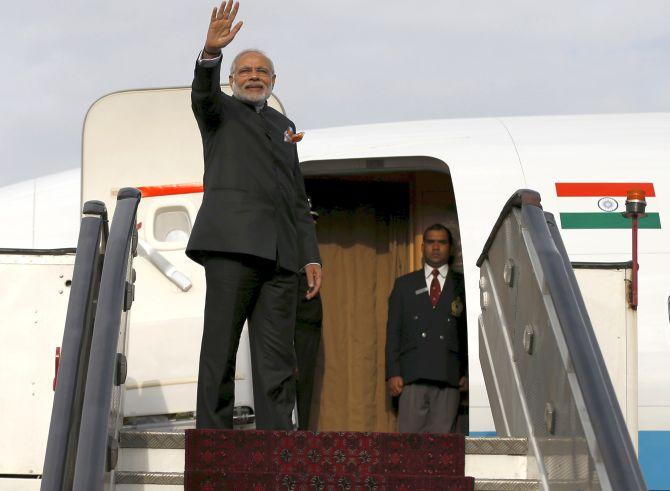PM Modi’s Foreign Trips Cost Over 22 Crore Since 2019
The government has spent an amount of Rs 6,24,31,424 on the visits of the President, an amount of Rs 22,76,76,934 on the visits of the Prime Minister, and an amount of Rs 20,87,01,475 on the visits of the Minister of External Affairs since 2019, according to the minister.

Since 2019, PM Modi went on 21 foreign trips in which approximately Rs, 22.76 crores were spent, according to the data released by the government recently. The President has undertaken eight foreign trips and more than Rs 6.24 crore were used for these trips, as informed by V Muraleedharan.
The government has spent an amount of Rs 6,24,31,424 on the visits of the President, an amount of Rs 22,76,76,934 on the visits of the Prime Minister, and an amount of Rs 20,87,01,475 on the visits of the Minister of External Affairs since 2019, according to the minister. While the president made eight foreign visits, the prime minister made 21 trips since 2019. During this time, S Jaishankar, the External Affairs Minister went for 86 external visits.
PM Narendra Modi has gone to Japan three times, and the UAE twice, since 2019. Talking about the president’s visits, a total of eight trips, of which 7 were by Ram Nath Kovind, while Droupadi Murmu, our present president went to the United Kingdom last September.
Details Of The Last 5 Working Years
According to data presented in the Rajya Sabha recently, expenditure of a little over Rs 239 crore was incurred during Prime Minister Narendra Modi’s travel to different foreign nations in the last 5 years.
Muraleedharan was responding to a question in the Rajya Sabha about the Prime Minister’s visits, their result, and details of the expenditure incurred on each of the visits in the last five years. The minister said such visits are an important means by which India serves its national interests and realizes its foreign policy.

He commented that these visits will benefit India in long run, strengthen the bond between nations, and clear India’s vision and perspective. It will help India in raising its point of view and getting support on global concerns that include environmental health, global relation, exports, imports, etc. In his written reply, Muraleedharan provided details of Modi’s visit, which began with his three trips to the Philippines in November 2017.
The minister said that expenses related to PM Modi’s travel to Bangladesh in March 2020, the USA (September 22-26, 2021), Italy, and the United Kingdom (October 29-November 2, 2021) were covered by the Interior’s Ministry head budget. The total expenditure on 31 trips is Rs 239,04,08,625 as per the details.
According to details, a maximum of Rs 23,27,09,000 was spent on PM Modi’s travel to the US in September 2019, while a minimum of Rs 23,86,536 was used during his travel to Japan in 2022, from 26 to 28 September.
Analysis of Visits
Prime Minister Narendra Modi’s worldwide trot was at the center of attention throughout his 8-year tenure. Talking about the last 8 years, the PM has made more than 110 foreign visits, covering more than 60 countries worldwide. From addressing diaspora mega gatherings to photo shoots with world leaders to inks landmark agreements, the Prime Minister left a deep impact on the world stage an effort to raise India’s global standing. PM Modi has already logged 114 visits and still has two years left in his tenure.

If we compare to Manmohan Singh, he has 73 visits in the 10 years of his tenure. Interestingly, the US is the country that Prime Minister Modi has visited the maximum number of times i.e., 7. The Prime Minister visited France, Germany, Russia, and China 5 times each.
The busiest year – 2015
In 2015, PM Modi covered 28 countries and hence was considered the busiest year. In 2018 too, PM Modi made more than 20 foreign visits. However in 2019 – which was an election year, the number of visits dropped to 14. Notably, the Prime Minister’s foreign visits drastically reduced during the year of the covid pandemic.In 2020, Narendra Modi visited four nations. When there were lockdowns all over the globe, then prime minister Modi didn’t visit any nation.
Historical visits
From addressing thousands of supporters in Houston, Texas to addressing a packed house parliaments in Britain and Australia, Prime Minister Modi created several iconic moments during his visits, where he addressed people from different states, from the different states including Texas, the parliaments of Britain, and Australia. However, some visits stood out for their rarity. For example, in 2017, Modi became the first Indian Prime Minister to visit Israel, marks a turning point in India’s position towards the country. In 2018, the current PM became the first ever sitting Indian Prime Minister to do so official visit to Palestine.

Another visit that stands out is Prime Minister Modi’s impromptu visit to Pakistan’s return from Kabul. However, PM Modi has not visited the neighbor since 2015 as a result of cross-border attacks. The recent attacks of cross-border have reduced the table talks due to differences of thoughts between the countries. Be it China or Pakistan, the difference in the interests of these nations have always been an obstacle in development.
Edited by Prakriti Arora



